The Tretyakov in Moscow is one of Russia’s – and the world’s – foremost art galleries. Founded by Russian tsarist-era industrialist and entrepreneur Pavel Tretyakov, the museum now displays some of staples of Russian and Soviet classic art.
AdMe.ru, a Russian site dedicated to Russian popular culture and advertising, dug through the art museum’s collection and selected ten paintings with interesting histories. We hope they will inspire you to make a trip to the Tretyakov Gallery.
You can read the original in Russian here. This has been translated for the first time into English by SRAS Translate Abroad intern Sophia Rehm.
The Apotheosis of War
by Vasily Vereshchagin
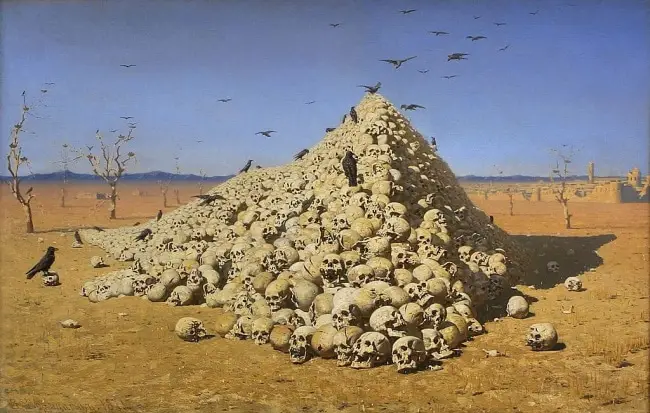
This work was painted in 1871, and was influenced by Russia’s military operations in Turkestan, which were striking to witnesses for their brutality. The painting was initially called The Triumph of Tamerlane, after the ruler (also known as Timur) whose troops left behind pyramids of sculls. According to the story, the women of Baghdad and Damascus once complained to Tamerlane that their husbands were mired in sin and debauchery. The cruel commander ordered every soldier in his 200,000-strong army to bring him the severed head of one of these lecherous husbands. Once the order was carried out, seven pyramids were made from the heads.
The artist later decided to give broader meaning to the painting. Vereshchagin wrote “The Apotheosis of War” on the frame, and added: “Dedicated to all the great conquerors, past, present and future.”
The Unequal Marriage
by Vasily Pukirev
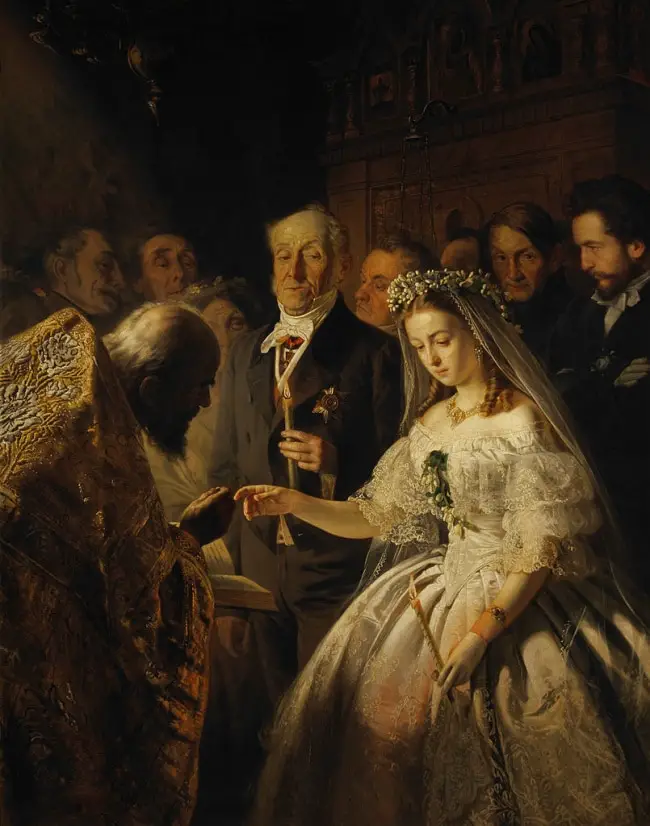
This painting depicts a wedding ceremony in an Orthodox church. The young, dowerless bride is marrying an old official against her will. According to one theory, the painting depicts the artist’s own romantic drama. Vasily Pukirev’s former bride-to-be served as the prototype for the image of the bride. Also, the image of the best man, shown behind the bride at the edge of the painting, with his arms across his chest, portrays the artist himself.
Boyarynya Morozova
by Vasily Surikov
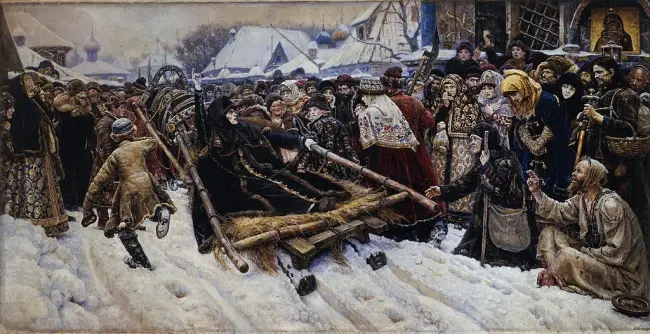
This giant painting (10 ft. by 20 ft.) by Vasily Surikov depicts a scene from the history of the 17th century schism of the Russian Orthodox Church. The painting is dedicated to Feodosia Prokopiyevna Morozova, an associate of archpriest Avvakum, who was a spiritual leader of the Old Believers. Around 1670 she secretly became a nun, in 1671 she was arrested, and in 1673 she was sent to the Pafnutevo-Borovski Monastery, where she was starved to death in an earthen prison.
The painting depicts an episode when the boyarynya (boyar’s wife) Morozova is transported through Moscow to the place of captivity. Next to Morozova is her sister Yevdokiya Urusova, who shared the dissenter’s fate; in the background is a pilgrim, in whose face the artist’s features can be found.
Unexpected Return
by Ilya Repin
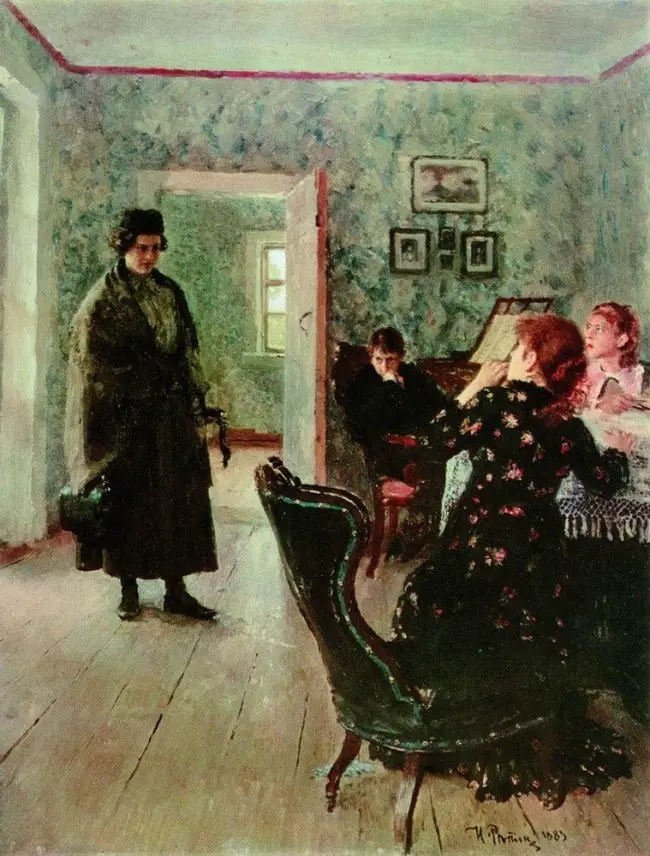
There are two versions of the painting Unexpected Return. The first of them was begun in 1888, and it depicted a student returning to her family. This version was painted in oil on wood.
The second painting, painted in 1884-1888, depicts the moment of the unexpected return home of a political exile. The little boy and the woman at the piano (seemingly his wife) are delighted; the little girl looks at him warily; the chambermaid is incredulous; and in the foreground, the hunched figure of his mother conveys deep emotional shock.
Today, both paintings belong to the Tretyakov Gallery’s collection.
Note that the title of the work is sometimes translated as An Unexpected Visitor or as They Did Not Expect Him. We have used the translation used by the Tretyakov Gallery here.
Trinity
by Andrei Rublev
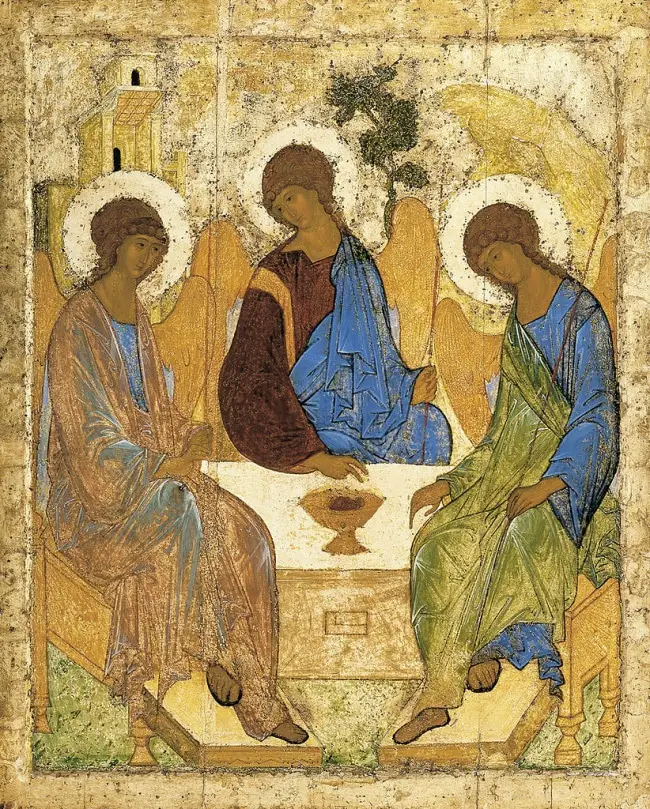
The Tretyakov Gallery has a rich collection of Old Russian paintings of the 11th-17th centuries, including the works of Dionisius, Simon Ushakov, and Andrei Rublev. In the Tretyakov’s Exhibition Hall 60 hangs one of the most famous and celebrated icons in the world: Trinity, painted by Andrei Rublev in the first quarter of the 15th century. Three angels are gathered around a table for a quiet, unhurried conversation. On the table sits a sacrificial bowl.
Trinity is kept in Tretyakov’s Hall of Old Russian Art, in a special glass enclosure, which maintains constant temperature and humidity and protects the icon from any damage.
Portrait of an Unknown Woman
by Ivan Kramskoi
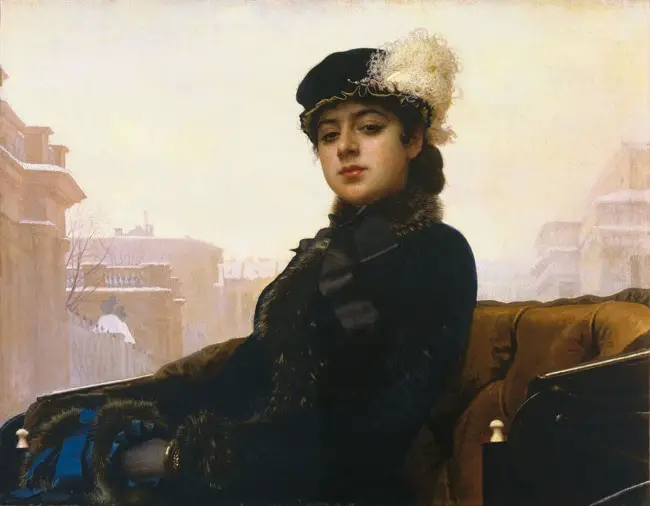
There is no doubt as to this painting’s setting: St. Petersburg’s Nevsky Prospekt, specifically the Anichkov Bridge. But the image of the woman still remains the artist’s secret. Kramskoi left no references to the identity of the unknown woman in letters or journals. Critics have associated the image with Lev Tolstoy’s Anna Karenina, Fyodor Dostoyevsky’s Nastasya Filipovna, and other famous women. There is also a theory that the painting depicts the artist’s daughter, Sophia Ivanovna Kramskaya.
In Soviet times, Kramskoi’s Portrait of an Unknown Woman became practically a Russian Sistine Madonna – the ideal embodiment of unearthly beauty and spirituality. It hung in every respectable Soviet home.
Beauty
by Boris Kustodiev

The artist’s son recalls how Kustodiev painted one of his most famous paintings: “He worked on the painting every day, beginning at six or seven o’clock in the morning and working all day. The painting was based on a drawing done in pencil and red chalk, from life (the model was an actress from the Moscow Art Theater). The down blanket, which my mother gave my father for his birthday, was also painted from life.
“My grandmother, who was living in St. Petersburg that summer, once brought us three plaster figurines she bought at the Sytny Market. My father loved them, and he painted them into the painting (on the bureau, to the right). In our home, we had a wonderful antique chest., It had an iron face painted with red roses in a vase on a black background. My father used this motif for the pattern on the chest in the painting, although he changed the color.”
Bogatyrs
by Viktor Vasnetsov

Vasnetsov worked on this painting for almost twenty years. It was finished on April 23, 1898, and soon bought by Pavel Tretyakov for his gallery.
In Russian epics, Dobrynya and Alyosha (two of the three famous fairytale “bogatyrs,” or knights) are young, but for some reason Vasnetsov portrayed Dobrynya as a grown man with a lush beard. Some researchers think that Dobrynya’s features resemble those of the artist himself. The prototype for Ilya Muromets (the third bogatyr) was a peasant from the Vladimir Province, Ivan Petrov, whom Vasnetsov had rendered before in one of his studies.
It’s worth mentioning that Ilya Muromets is not a fairy-tale character, but a historical figure. The story of his life and feats of arms describe real events. When he grew old and finished toiling to protect his homeland, he became a monk of the Kiev-Pechersk Monastery, where he died in 1188.
Bathing of a Red Horse
by Kuzma Petrov-Vodkin
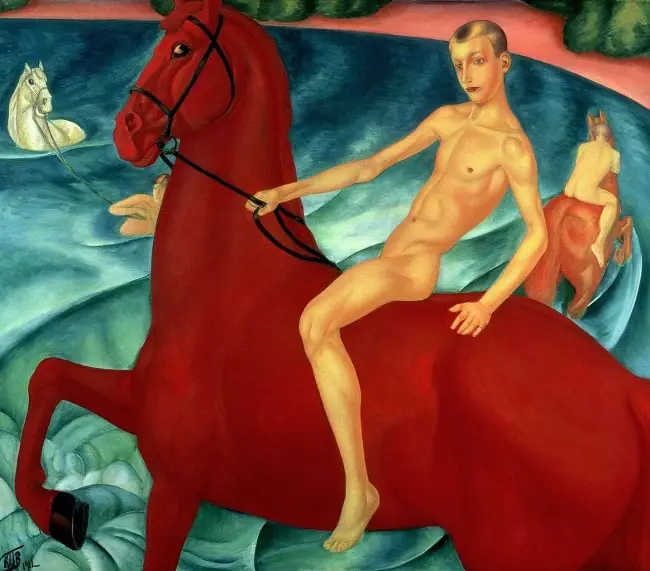
The painting Bathing of a Red Horse, which amazed contemporaries with its monumentality and significance, brought artist Kuzma Petrov-Vodkin world fame. The Red Horse stands for the Fate of Russia, which the fragile, young rider cannot rein in. According to another interpretation, the Red Horse is Russia itself. In this case, it is impossible not to note the artist’s prophetic gift: in this painting he symbolically predicted the “red” fate of Russia in the 20th century.
Petrov-Vodkin painted the horse from a real stallion named “Boy.” For the image of the youth sitting astride the horse, the artist used the features of his pupil, the artist Sergey Kalmykov: “For the information of my future biographers. My dear Kuzma Sergeevich painted me on the red horse… I was the model forthe languid youth in the painting.”
The Swan Princess
by Mikhail Vrubel

This work was painted in 1900 based on the stage version of the heroine of Rimsky-Korsakov’s opera The Tale of Tsar Saltan, from the fairy-tale of the same name by Alexander Pushkin. Vrubel designed the set of the performance, and the artist’s wife, Nadezhda Zabela-Vrubel, played the part of the Swan Princess. “Most singers sing like birds, but Nadya sings like a human being!” Vrubel said of her.






